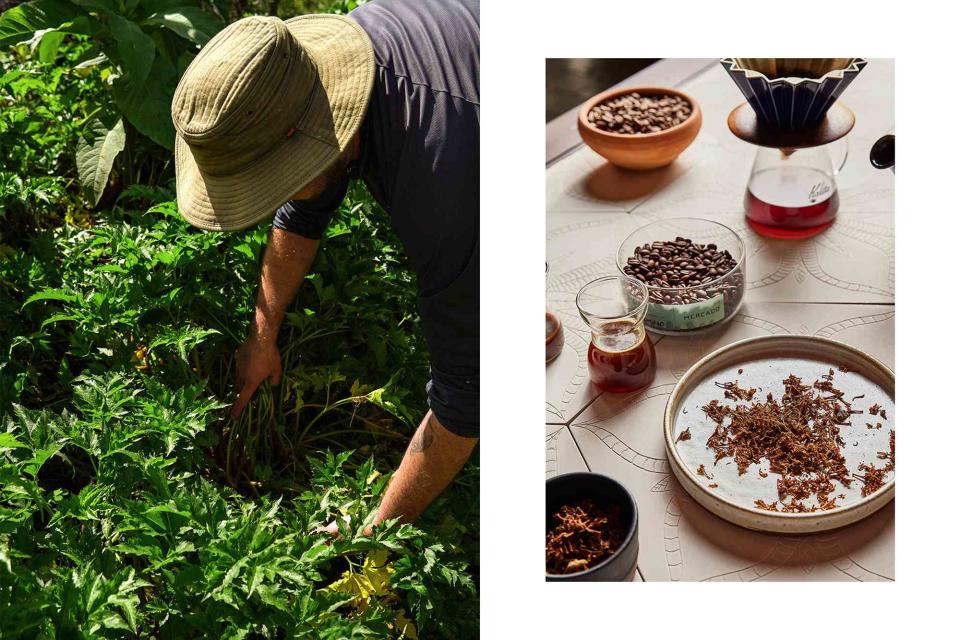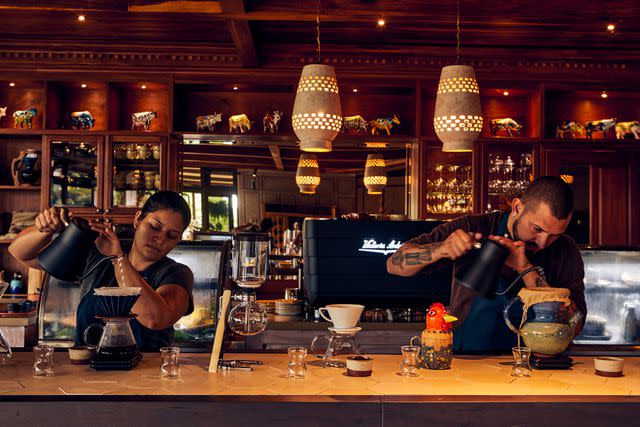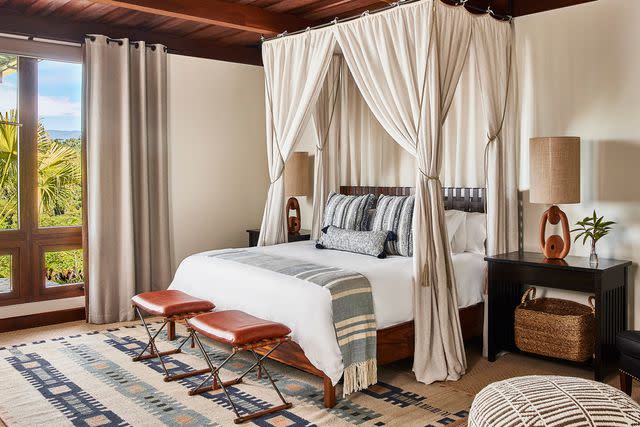Costa Rican Coffee Culture Is World Renowned — Here's the Best Way to Experience It
The Costa Rican bean is prized among coffee connoisseurs, but it’s just one of a cornucopia of unique foods produced in the country.

Courtesy of Hacienda AltaGracia, Auberge Resorts Collection
From left: Harvest time at the farm of Doña Tere, in the town of Cedral; a coffee tasting at Mercado.When it comes to coffee, Costa Rica has a robust profile: the country ranks 124th in the world in terms of population, but is the 22nd-largest coffee exporter. Where Costa Rica excels is not in volume, however, but quality. With its hilly terrain, tropical precipitation, and acidic, volcanic soil, the country is home to a wide array of small producers — most cultivate 12 acres or less — that farm superior arabica beans. Despite this, many visitors may get no closer to Costa Rican coffee than the Chocolatería Britt café at the San José airport.

Courtesy of Hacienda AltaGracia, Auberge Resorts Collection
Brewing coffee at Mercado, a café and shop within Hacienda AltaGracia.A more full-bodied experience can be had at Hacienda AltaGracia, Auberge Resorts Collection, a hotel in the foothills of the Talamanca mountain range with 50 casitas dotted among 180 densely forested acres. As part of what resort manager Koen Masschelein calls “AltaGracia 2.0,” the property has focused on connecting with local communities — particularly via food.
The day of my arrival — via the hotel’s own Cessna turboprop, which ferries guests from San José to its private runway — Masschelein and I sat in the Mercado, a small café and gift shop that serves as a meeting place for the sprawling property. We had just had an extensive coffee tasting, courtesy of Adrey “Tacho” Perez Salazar, who was busily preparing for the Costa Rican preliminaries of the World Barista Championship. Tacho poured me and my friend Jon — a Tico who now lives in New Jersey — cups of red-honey-processed Gesha coffee. However, each cup was prepared in a different way, including in a vandola, a ceramic jug with a conical top. The coffee comes from Corazón de Jesus, one of a number of local micromills.
How local? As the label says on the bags of beans for sale in Mercado, “this coffee traveled less than five miles to get to AltaGracia.” The resort is trying to shrink that number even further, Masschelein told me, and is partnering with local growers like Los Jilgueros, a cooperative in nearby Cedral, to plant trees on the grounds of AltaGracia. “Next year,” he said, “we’re going to roast our own coffee right here.”

Courtesy of Hacienda AltaGracia, Auberge Resorts Collection
One of two bedrooms in AltaGracia's Casa Grande con Piscina.Coffee is just part of the rich agricultural landscape that surrounds AltaGracia, which the hotel encourages visitors to interact with. The next morning, I set off in a tan 1978 Toyota Land Cruiser, bumping along a dirt track with Arno Janse van Rensburg and Liezl Odendaal, the husband-and-wife team who were until recently AltaGracia’s head chef and culinary director. We were on our way to visit (as any guest can) Marvin Arias Gonzalez, who runs Finca Capicacao, a small farm a short drive from the hotel. “Marvin was one of the first farmers we met when we came,” Odendaal told me.
The couple previously helmed Janse & Co., a restaurant in Cape Town. When they arrived at AltaGracia, they were told that they would have to import part of what they needed from the U.S. and Mexico, “because the produce here just isn’t good enough,” van Rensburg recalled. The couple spent months scouring the countryside for purveyors, and they estimate that AltaGracia’s food program is now about 85 to 90 percent local.
At Arias Gonzalez’s farm, the couple found everything from cacao and peppercorns to turmeric and mariola honey and the up-and-coming South American superfood sacha inchi. They’ve also found in Arias Gonzalez a dynamic entrepreneur always looking for ways to improve and diversify his production.
On top of everything, Arias Gonzalez is a born raconteur. Drink a cup of freshly made cacao with him at the new outdoor space he’s built to welcome guests (the majority of whom come via AltaGracia), or walk the winding trails of his 50-acre property, which includes a stretch of wild forest replete with howler monkeys. You’ll be treated not only to random fruits plucked from trees — jocote, pejibaye, manzana de agua — but to a stream of amusing anecdotes.
As we talked, he described a recent call from a woman in Spain looking to buy “ceremonial-grade” cacao — meaning, among other things, that he was supposed to “breathe and say thanks to nature” as he harvested it.
The next day, back in the Land Cruiser, Jon and I climbed roads lined with bounteous hydrangeas and spotted the occasional iridescent flash of a blue morpho butterfly. We sampled a range of cheeses, including the addictive palmito — a sort of Costa Rican string cheese — at Lácteos de Don Aurelio, another of the suppliers to AltaGracia.
In the hamlet of Cedral, we stopped at Los Jilgueros, where we were served coffee prepared in a chorreador, a classic Costa Rican device featuring a simple wooden stand and a fine-mesh “sock.” A few doors down, we visited the Casa de Bamboo, a local cantina that is actually the festively decorated den of a private home, where Doña Tere served us her locally famous “espíritus” — winelike drinks fermented from fruits like jaboticaba and tucuico, harvested from her own farm.
Most of these foods and flavors were new to me. Some were even new to Jon, who has lived outside of Costa Rica for decades. “I feel like I’m rediscovering my country,” he announced. Food is a direct route to memory, I thought as I sipped a homemade wine, but it can also be a thrilling pathway to discovery.
Doubles at Hacienda AltaGracia from $1,620, all-inclusive.
For more Travel & Leisure news, make sure to sign up for our newsletter!
Read the original article on Travel & Leisure.

